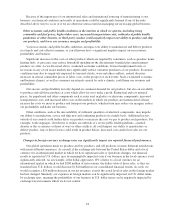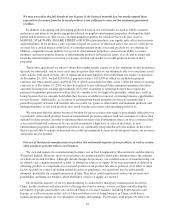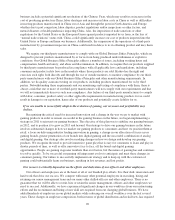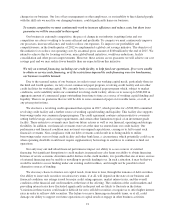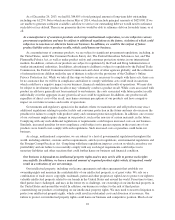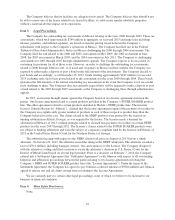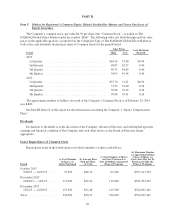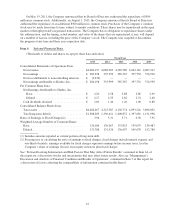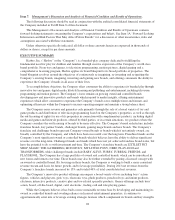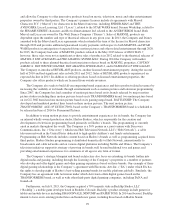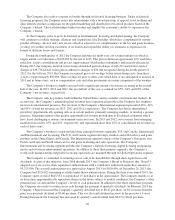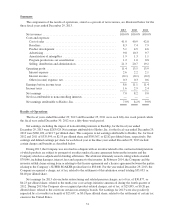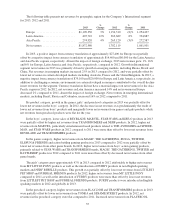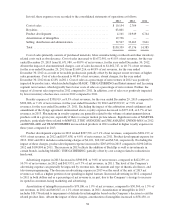Hasbro 2013 Annual Report Download - page 40
Download and view the complete annual report
Please find page 40 of the 2013 Hasbro annual report below. You can navigate through the pages in the report by either clicking on the pages listed below, or by using the keyword search tool below to find specific information within the annual report.
Item 7. Management’s Discussion and Analysis of Financial Condition and Results of Operations.
The following discussion should be read in conjunction with the audited consolidated financial statements of
the Company included in Part II Item 8 of this document.
This Management’s Discussion and Analysis of Financial Condition and Results of Operations contains
forward-looking statements concerning the Company’s expectations and beliefs. See Item 1A “Forward-Looking
Information and Risk Factors That May Affect Future Results” for a discussion of other uncertainties, risks and
assumptions associated with these statements.
Unless otherwise specifically indicated, all dollar or share amounts herein are expressed in thousands of
dollars or shares, except for per share amounts.
EXECUTIVE SUMMARY
Hasbro, Inc. (“Hasbro” or the “Company”) is a branded-play company dedicated to fulfilling the
fundamental need for play for children and families through creative expression of the Company’s world class
brand portfolio. From toys and games, to television programming, motion pictures, digital gaming and a
comprehensive licensing program, Hasbro applies its brand blueprint to its broad portfolio of properties. The
brand blueprint revolves around the objectives of continuously re-imagining, re-inventing and re-igniting the
Company’s existing brands, imagining, inventing and igniting new brands, and offering consumers the ability to
experience the Company’s brands in all areas of their lives.
To accomplish these objectives, the Company offers consumers the ability to experience its branded play through
innovative toys and games, digital media, lifestyle licensing and publishing and entertainment, including television
programming and motion pictures. The Company’s focus remains on growing owned and controlled brands,
developing new and innovative products and brands which respond to market insights, offering entertainment
experiences which allow consumers to experience the Company’s brands across multiple forms and formats, and
optimizing efficiencies within the Company to increase operating margins and maintain a strong balance sheet.
The Company earns revenue and generates cash primarily through the sale of a broad variety of toy and
game products and distribution of television programming based on the Company’s properties, as well as through
the out-licensing of rights for use of its properties in connection with complementary products, including digital
media and games and lifestyle products, offered by third parties, or in certain situations, toy products where the
Company considers the out-licensing of brands to be more effective. The Company’s brand architecture includes
franchise brands, key partner brands, challenger brands, gaming mega brands and new brands. The Company’s
franchise and challenger brands represent Company-owned brands or brands which if not entirely owned, are
broadly controlled by the Company, and which have been successful over the long term. Franchise brands are the
Company’s most significant owned or controlled brands which it believes have the ability to deliver significant
revenue over the long-term. Challenger brands are brands which have not yet achieved franchise brand status, but
have the potential to do so with investment and time. The Company’s franchise brands are LITTLEST PET
SHOP, MAGIC: THE GATHERING, MONOPOLY, MY LITTLE PONY, NERF, PLAY-DOH and
TRANSFORMERS, while challenger brands include BABY ALIVE, FURBY, FURREAL FRIENDS, and
PLAYSKOOL. The Company has a large portfolio of owned and controlled brands, which can be introduced in
new forms and formats over time. These brands may also be further extended by pairing a licensed concept with
an owned or controlled brand. By focusing on these brands, the Company is working to build a more consistent
revenue stream and basis for future growth, and to leverage profitability. During 2013 net revenues from the
Company’s franchise brands increased by 15% and totaled 44% of total consolidated net revenues.
The Company’s innovative product offerings encompass a broad variety of toys including boys’ action
figures, vehicles and playsets, girls’ toys, electronic toys, plush products, preschool toys and infant products,
electronic interactive products, creative play and toy-related specialty products. Games offerings include boys’
action, board, off-the-board, digital, card, electronic, trading card and role-playing games.
While the Company believes it has built a more sustainable revenue base by developing and maintaining its
owned or controlled brands and avoiding reliance on licensed entertainment properties, it continues to
opportunistically enter into or leverage existing strategic licenses which complement its brands and key strengths
28


